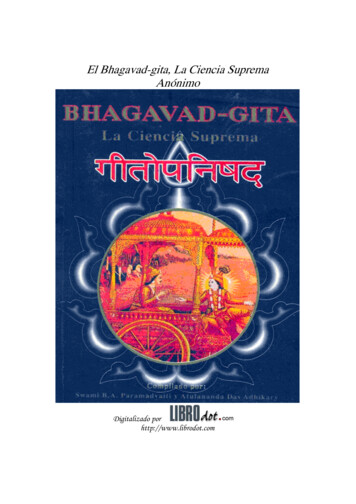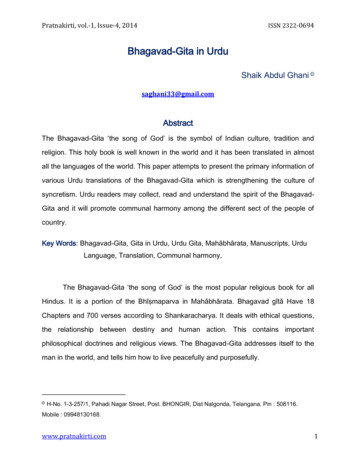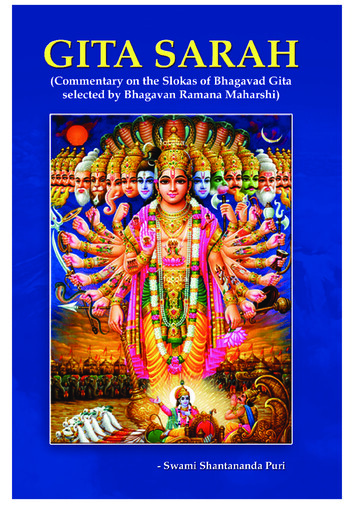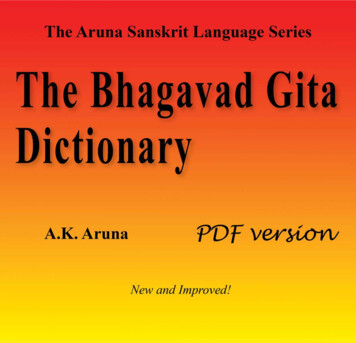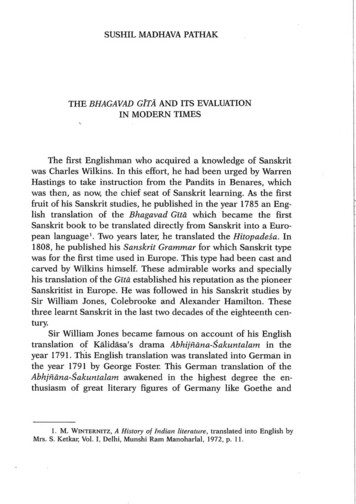
Transcription
1
The Bhagavad Gita For AwakeningA Practical Commentary for Leading a SuccessfulSpiritual LifeAbbot George Burke(Swami Nirmalananda Giri) 2021 Light of the Spirit MonasteryLight of the Spirit PressCedar Crest, New Mexico, USALightoftheSpiritPress.comOCOY.org2
Bhagavad Gita–The Book of LifeSeveral thousand years ago in north-central India, two people sat in a chariot inthe midpoint of a great battlefield. One of them, the yogi Arjuna, knew that itwould not be long before the conflict would begin. So he asked Krishna, the Masterof Yoga (Yogeshwara), what should be his attitude and perspective in this moment.And above all: What should he do?There was no time to spare in empty words. In a brief discourse, later turnedinto seven hundred Sanskrit verses by the sage Vyasa, Krishna outlined to Arjunathe way to live one’s entire life so as to gain perfect self-knowledge and selfmastery.The battle was ferocious and–as always with war–everyone lost. But when Vyasawrote his epic poem, the Mahabharata (The Great Indian War), he put Krishna’sinspired teachings into it as a precious jewel. Instantly they were extracted, namedBhagavad Gita (The Song of God), and circulated throughout the subcontinent.That was several thousand years ago, and today the Gita is found in nearly everyhousehold in India and has been translated into every major language of the world.Literally billions of copies have been handwritten and printed. (A few years ago aspiritual organization in South Africa printed one million copies for freedistribution.) When Rudyard Kipling became a Freemason in Lahore, fourscriptures were on the altar, including the Bhagavad Gita.What is the appeal of the Gita? First of all, it is totally practical, free of anyvague or abstract philosophy. During my first trip to India over forty years ago, Iheard about a yogi who lived in a small houseboat on the Ganges river in the holycity of Benares (Varanasi). He never spoke or wrote, yet every day for many yearspeople came to him for advice. How did he manage? He had a copy of the BhagavadGita, and after he was told the problem or question he would open the book, pointto a portion, and the inquirer would have a perfect and complete solution to thetrouble.My own spiritual awakening began by kicking me out of the nest of comfortablereligion into a vast world of realities I had no idea how to cope with. I flounderedaround in the sea of my new horizons until one day I bought a paperback edition ofthe Bhagavad Gita. I did not read it, I inhaled it. I was not reading the words of along-dead teacher: my own Self was talking to me in the pages of that little book.Nor did I learn anything from the Gita–I remembered that which I had always known.Eternal Self spoke Eternal Truth. The Bhagavad Gita changed my life by giving meLife that has never ended.Nothing has ever arisen in my life, internal or external, that the Gita has notmade clear and enabled me to deal with or understand. Yet is it not dogmatic. Atthe very end Krishna says to Arjuna: “Now I have taught you that wisdom which isthe secret of secrets. Ponder it carefully. Then act as you think best.” No threats, nopromises, no coercion. It is all in the reader’s hands.3
Even better: the Bhagavad Gita tells us that we can attain a Knowing beyondeven what it tells us. And it shows us the way. It is a wise resolve to read the Gitaevery day without fail for the rest of one’s life.A practical suggestionThe translation used in this commentary is my own, but I recommend that youobtain other translations of the Gita, for it is impossible to produce a definitivetranslation of a text written in such a complex language as Sanskrit. I always checkat least four translations when looking into the meaning of a verse: those of SwamisPrabhavananda, Swarupananda, Sivananda, and that of Winthrop Sargeant. Isometimes consult those of Sri Aurobindo, Gandhi, and William Judge, as well.I would like to point out that reading any English-only translation of the Gita,however good, will only be skimming the surface. This is because of the manymeanings of Sanskrit words–meanings that were in the mind of Vyasa and that wereused for that very reason. In the West we have the idea that spiritual texts have butone meaning, and that may be so for some, but this is not at all the case for Sanskrittexts which are intended to have multi-level messages and subtle nuances. Wordswhich carry several relevant ideas are ideal for the profound wisdom of the Gita andUpanishads, particularly.In the Gita translation, words in parentheses indicate alternate readings of theactual Sanskrit word preceding them. Those alternate readings are as legitimate asthe English term I have used. Brackets indicate words not in the Sanskrit text butinserted by me to clarify the meaning.Because of this I recommend that you obtain translations of the Gita thatcontain the Sanskrit text with word-by-word translations as well as the usual verseform. Sargeant’s translation is definitely the best for this, but it would be good tohave one or two more. In addition you need some Sanskrit dictionaries. Irecommend: A Concise Dictionary of Indian Philosophy by John Grimes, The Yoga-VedantaDictionary of Swami Sivananda, Sanskrit Glossary of Yogic Terms by Swami Yogakantiand A Sanskrit Dictionary by John M. Denton. My own endeavor, A Brief SanskritGlossary, is certainly helpful, and definitely complements them.Swami Nirmalananda Giri(Abbot George Burke)4
The Battlefield of the MindMost of us have heard the story of the centipede who, when asked how hemanaged to walk with so many legs, tangled his legs in the attempt to figure it outand ended up on his back, helpless. This is not unlike the person who attempts toplumb the depths of oriental scriptures. Right away it becomes evident that theyconsist of incalculable layers, many symbolic in nature. Furthermore, the meaningsof the symbols are not consistent, changing according to the levels on which theyoccur. For example, on one level water symbolizes the mind, on another level theconstant flux of samsara, and on another the subtle life-currents known as prana.This being the case, the Western linear mode of thought becomes as entangled anddisabled as the fabled centipede. Knowing this to be so, I have decided to avoidsubtle symbolism and concentrate instead on the obviously practical side ofKrishna’s teachings in the Bhagavad Gita. (For an exposition of the symbolism ofthe Gita, see Paramhansa Yogananda’s commentary, God Talks With Arjuna: TheBhagavad Gita.) However I do want to take some time and consider the obvioussymbolism encountered in the first chapter of the Gita.We find ourselves on Kurukshetra, a field of impending battle. It is not as vast asour Hollywood-epic-shaped minds might imagine, as can be seen for oneself by avisit to Kurukshetra, not very far from Delhi. At one end is a hillock topped with ahuge tree under which there is a great bronze statue of Arjuna, Krishna and theirchariot. (When I was there only the tree and a large marble replica of the chariotmarked where they sat.) This is the vantage point from which Arjuna, the greatwarrior, and Sri Krishna, his teacher, looked out over the field. Today its tranquillityis charming, despite the strong feeling in the air that something tremendouslymomentous occurred there in the distant past. It is both awesome and soothing.For background information regarding how the battleground came to bethronged with soldiers, chariots, elephants and the other paraphernalia of a deadlywar, see the introductory essay, “Gita and Mahabharata” in Swami Prabhavananda’stranslation The Song of God.Suffice it to say that the two opposing armies are very easy to morally identify.The Kauravas, led by the murderous Prince Duryodhana, are fundamentally evil,although many honorable men have, through various complicated alliances andobligations, found themselves among their ranks. The Pandavas, headed by thevirtuous and noble Yudhisthira, the eldest brother of Arjuna, are embodiments ofall that is good, among them being the divine Sri Krishna himself who chose to bethe charioteer of Arjuna.The symbolism is not very hard to figure out (leaving aside the complex matterof assigning a symbolic meaning to every person named in the battle narrative).Kurukshetra is the personality–particularly the mind (intellect)–of the awakenedseeker for higher consciousness. Such a seeker, determined to end the whirling cycle5
of birth and death, finds that his aspiration itself has inspired opposition fromwithin his own mind and heart, where good and evil, truth and falsehood, ignoranceand wisdom, like the Kauravas and Pandavas, have drawn themselves up inreadiness for a conflict that must end in the annihilation of one side or the other.Even more daunting is the fact that much considered good is found lining up insupport of negativity, and most of the Pandava side will also be blotted out in theeventual transmutation of the individual into a higher state of being itself, much asthe endearing ways of infancy and childhood must be eradicated at the advent ofadulthood and replaced with completely different virtues.In the chariot set betwixt the two armies we find Arjuna and Krishna. Manyinterpretations of these two pivotal figures are possible, nearly all of them correct,but the words of the Mundaka Upanishad, written long before the Gita, arecertainly worthy of our attention.“Like two birds of golden plumage, inseparable companions, the individual selfand the immortal Self are perched on the branches of the selfsame tree. The formertastes of the sweet and bitter fruits of the tree; the latter, tasting of neither, calmlyobserves.“The individual self, deluded by forgetfulness of his identity with the divine Self,bewildered by his ego, grieves and is sad. But when he recognizes the worshipfulLord as his own true Self, and beholds his glory, he grieves no more” (MundakaUpanishad 3:1:1, 2. This is the translation found in The Upanishads, Breath of theEternal, by Swami Prabhavananda.)These two paragraphs are a perfect picture of the setting of the Gita. Arjuna isthe bewildered and sorrowing Atma, the individual Self, and Krishna is the divineParamatma, the Supreme Self from which the Atma derives its very being andexistence. Forgetful of its true nature as part of the Infinite Spirit, the finite spiritpasses through countless experiences that confuse and pain it, producing utterlyfalse conclusions that compound and perpetuate the confusion and pain. Only whenthe perspective of the Divine Self is entered into, can its troubles cease. We can alsothink of Arjuna as our lower, mortal self, and Krishna as our higher, immortal Self.Krishna and Arjuna thus represent both God and Man and our own (presently) dualnature as mortal and immortal. Keeping this perspective before us, the ensuingdialogue which forms the Gita is to be seen both as God’s communication to humanbeings and the communication of our own divine Self with our human self,liberation (moksha) of the spirit being their sole intention.With this in mind, we are ready to begin. I will be using my own version of theGita which is based a great deal on the translation of Winthrop Sargeant: TheBhagavad Gita, published by State University of New York Press, which I recommendas an excellent version, especially since it gives a word-by-word translation of theentire text. The translation of Swami Prabhavananda is unparalleled for beauty andinterpretation, so I recommend both translations.6
On The Field of DharmaWe begin with King Dhritarashtra, the blind father of the evil Duryodhana:Dhritarashtra said: Assembled there on dharma’s field–Kurukshetra–desiring war, what did my sons and the Pandavas, O Sanjaya? (1:1)The opening words of this verse are dharmakshetre kurukshetre: “the field ofdharma, the field of the Kurus.” Dharma means the right way of thought and action,but it can also mean the accurate expression of one’s own dominant character, fordharma also means “quality.” This entire world is a dharmakshetra, a field uponwhich we act out the character of our inner makeup–i.e., the quality of ouremotions, mind, intellect, and will. We as individuals are each a dharmic field,expressing the actuality of our present level of evolution.How is it, though, that the field of dharma is the field of the Kurus, the enemiesof dharma? This is necessary for the portrayal of our present situation here in theworld. Not only do negativity and ignorance–the enemies of dharma–dominatesociety in general, we find within ourselves a welter of negative impulses, conflicts,confusions, fears, and ignorance of all kinds. Yes; we are definitely in–and are–thefield of the Kurus, whatever our intentions may be. We are going to have to fightthrough the whole field and wipe out all the Kurus and most of the Pandavas.Remember, we have lived millions of lives: mineral, plant, animal, and human, andwe have brought all the impressions (samskaras) and habits (vasanas) of those livesalong with us. Our past is our present. No wonder we are in trouble! But, as SwamiSri Yukteswar often said: “Forget the past. The vanished lives of all men are darkwith many shames. Human conduct is ever unreliable until anchored in the Divine.Everything in future will improve if you are making a spiritual effort now.” And theGita will help us in this effort.Desiring to fightYuyutsavah certainly means “desiring to fight,” but it can also be translated“battle-hungry.” There is deep within us an impulse to divinity, but it has beenoverlain and overruled by a multitude of impulses to delusion and delusionproduced desires. So they both fight with each other–often on the subconsciouslevel. Both are “battle-hungry” for they are fighting for their very life.The Mahabharata War is a historical fact, just as are the field of Kuruksheta,Krishna, and Arjuna. Yet Vyasa is using this setting and the conversation betweenKrishna and Arjuna to give us spiritual teachings, some of which are in symbol. Inthe real battle many families were represented on both sides, which depicts theinner conflicts of human beings, whether spiritually awakened or not.The warriors of ignorance and delusion are children of the blind ego(Dhritarashtra), whereas the the inner soldiers of truth and higher consciousnessare the children of the Spirit-Self, the divine Atman. The ego is the false self that7
reigns on the throne of our minds and hearts, blinding us to everything else,making us think that it is the reality of our being–that we are it. But it is a lie.Buried deep within is the real Self, awaiting its liberation and possession of itsrightful kingdom. This is why the evil twin/good twin plot always appeals topeople; it is symbolic of our dilemma of false self/real Self.Son of Ego–more of the sameSanjaya said: King Duryodhana, seeing the Pandava forces ranged ready forbattle, approaching his teacher, Drona, spoke these words: (1:2).Duryodhana is certainly his father in extension, but more dangerous because hecan see–that is, he can consciously choose evil if he feels it suits his own ends. (Bythe way, Dhritarashtra literally means “He by whom the kingdom is held,” andDuryodhana means “dirty fighter.”)The Bhagavad Gita occurs in the Mahabharata epic only after an immenseamount of historical material is given, showing all that led up to the battle. Therewe see Duryodhana as one of the foulest, most evil figures in recorded history.Many times he attempted to kill the Pandava brothers, whose kingdom he hadusurped. He also plotted the death of Krishna several times. He is evil, and Vyasa isgoing to show this to us by his conversation with Drona, a venerable man who washis teacher, the one who had given him all his education and training as a kshatriya(a member of the warrior-ruling caste). Actually, the whole Gita consists of twoconversations: that between Duryodhana and Drona (though it was really amonologue in the style of all egotists) and that between Arjuna and Krishna. Arjunapleads with Krishna to teach him, but Duryodhana only seeks to set Drona straightand accuse him for also being the teacher of Arjuna who is now facing him as anopponent in battle. So it begins Behold, O Teacher, this great army of Pandu’s sons, assembled by Arjunayour brilliant pupil (1:3).See what I mean? “You got us into this mess” is the meaning. Next he rubs it inby enumerating the great warriors on the Pandava side:Here are heroes, mighty archers, Bhima and Arjuna’s equals, Yuyudhanaand Virata, and Drupada the great car warrior (1:4).Bhima, one of Arjuna’s brothers, was perhaps the strongest human being thathas ever lived. He was all brawn and no brains, but beloved by those who couldsurvive knowing him. He name means “tremendous,” but in the sense of terrifying.All those listed by Duryodhana are maharathas–mighty chariot-warriors (carwarriors) who could fight huge numbers of foot-soldiers singlehandedly.Drishtaketu, Chekitana, and the valiant King of Kashi, Purujit andKuntibhoja, and Shaibya: the mightiest among men. And courageousYudhamanyu, and valorous Uttamaujas; the son of Shubhadra and the sons ofDraupadi: all great car warriors (1:5-6).Well, that tells Drona! (Subhadra was Krishna’s sister. “The sons of Draupadi”are the children of the Pandava brothersGl.) Even though Drona got Duryodhana8
into this tangle (egotists always take the credit for success, even when it is not duethem, but always manage to blame someone else for failure), there is no need forworry.Those of ours who are indeed distinguished, now know. O highest of thetwice-born, the leaders of my army I now recount unto you by name (1:7).As if Drona would not know all of them very well! This is extremely insulting–asis the way of all bullies. The fact that he speaks of “my army” reveals his egotism.“Twiceborn” was a title referring to the three higher of the four castes, referring totheir having undergone a spiritual birth through initiation into the Gayatri mantraand the spiritual rites of Vedic religion.Your Lordship and Bhishma and Karna and Kripa, victorious in war,Ashwattama and Vikarna, and the son of Somadatta also. And many otherheroes, whose lives are risked for my sake, ready to discharge variousweapons, all very skilled in battle. (1:8-9).Yes, all those who serve ego and work to ensure its preservation are certainlyrisking their lives. It is amazing to see how the world and the ego devour a person,sapping his life, turning him into an aimless husk, and all the while he thinks he isreally living the good life. This is the fatal illusion in which humans dwell. Onlythose who have glimpsed the truth of their inner divinity have a chance at escapingthe realm of death.Bravado, not braverySufficient is that force of ours guarded by Bhishma; insufficient, though, isthat force guarded by Bhima. Stationed in your proper places, whatever beyour positions, certainly all of you: protect Bhishma (1:10-11).It is true that the Pandavas were greatly outnumbered by the Kauravas. Sonaturally, those that see only with the bodily eyes would think that their numberswere inadequate. But throughout history great victories have been won by a few–sometimes even by only one. In the Bible (the seventh chapter of Judges) we findthat God kept telling Gideon that he had too many soldiers, and ordering that hepare down their numbers. He did so, and they routed a huge number of soldierswithout even fighting! It is foolish to think that numbers make either strength orright. But that is the way of Duryodhana and his kind.Empty noiseTo make Duryodhana happy, the aged Kuru grandsire, Bhishma, bellowingwith a tremendous sound of a lion’s roar, then blew his conch with greatpower, making a tremendous sound. Thereupon the Kurus’ conches andkettledrums and cymbals and trumpets were sounded all at once, producing atumultuous uproar (1:12-13).This is nothing new. In many ways bullies and thugs make a lot of noise tointimidate others. And it often works. But not this time.9
Divine soundThen Krishna and Arjuna, standing in the great chariot that was yokedwith the white horses, sounded forth their divine conches (1:14).This is something completely different, not just more of the same. Thesymbolism here is important. Horses are symbolic of life-force, of prana, of energy/power itself. White horses symbolize the powers of Divine Light. Furthermore, theconches of Krishna and Arjuna were not mere seashells like those of the Kurus, theywere divyau–divine instruments of Light.All that exists is vibration. The sound of the Kurus’ conches represent thevibrations of Maya, of delusion and ignorance, of materiality and ego. But the soundof the Pandava conches represents the divine inner sound of the highest level ofconsciousness. The sound of the Kurus is intended to make the spirit faint, but thesound of the Pandavas, the vibration of Truth, enlivens, inspires, and strengthensthe spirit. The names of the conches are titles of Divine Sound and indicate itspowers when invoked by the yogi.Krishna blew Panchajanya, Arjuna blew Devadatta, and Bhima of ferociousdeeds, blew the great conch, Paundra. King Yudhishthira, Kunti’s son, blewon Anantavijaya, Nakula and Sahadeva blew on Sughosha and Manipushpaka(1:15-16).Panchajanya was the name of an evil enemy defeated by Krishna. Some say heowned the conch that later bore his name, some say that he was a shape-changingdemon that lived in the conch (which was under the sea), and others that Krishnamade a conch out of his bones. But a great yogi once told me during a conversationin Rishikesh that it is a contracted form of Panchavijaya, which means “FiveVictories,” meaning the spiritual victory over the five elements (bhutas) andmastery of the five bodies (koshas) and the five senses.Devadatta means “God-given,” the key to liberation given by God (Ishwara)himself to human beings.Paundra, the yogi told me, means mighty sound, or “of a mighty sound.”Anantavijaya means “unending victory.”Sughosha also means “making a great noise,” but the yogi said it also means“making a sweet, soothing sound.”Manipushpaka literally means “jeweled bracelet” or circlet. In verse seven of theseventh chapter we are told that “On me all this universe is strung like jewels on athread.” But the yogi told me its intended meaning is “mind like a flower,” openedlike a lotus at the shining of the light of the Self within. It can also mean “aerialchariot of the mind” opening and flying in the Sky of Consciousness, theChidakasha.Whether any of these meanings are correct or intended by Vyasa cannot beknown for sure, since Sanskrit also has undergone mutations over time. Anyhow,these are very good speculations, I think.The other Pandava leaders on the battlefield sounded their conches as well.And Kashi’s king, the supreme bowman, and the great warrior Shikhandi,10
and Dhristadyumna and Virata, and the invincible Satyaki, and Drupada andthe sons of Draupadi, O Lord of the Earth, and Shubhadra’s son, the mightyarmed, each blew upon his conch(1:17-18).This is a symbolic picture of the yogi engaged in the interior battle, who hasmarshalled all his faculties in meditation and united them, causing them to vibratethroughout his being. So the next verse says:Throughout the sky and the earth resounded the terrific noise which rentasunder the hearts of those in Dhritarashtra’s ranks (1:19).Divine Light and Divine Sound resound throughout the total being of the yogi,and burst apart the hearts of all the foes of the Self, first rendering them powerless,and then annihilating them.11
Taking StockThen seeing Dhritarashtra’s ranks drawn up in battle array for theforthcoming clash of weapons, Arjuna took up his bow, and said untoKrishna: O Lord of the earth, drive my chariot to stand in the midst betweenthe two armies, until I can behold these battle-hungry men arrayed here withwhom I must fight in this conflict. I would behold those who are about to givebattle, having assembled here wishing to do service in warfare for the evilminded son of Dhritarashtra. Thus addressed by Arjuna, Krishna brought thechief chariot to stand in the midst of the two armies. Thus facing Bhishma,Drona, and all the rulers of the earth, Krishna said: Behold, Arjuna, theseKurus assembled here. (1:20-25).Authentic, traditional yoga is very serious and circumspect, and the intelligentyogi believes in the old adage: Look Before You Leap. Jesus put it this way: “Whichof you, intending to build a tower, sitteth not down first, and counteth the cost,whether he have sufficient to finish it? Lest haply, after he hath laid the foundation,and is not able to finish it, all that behold it begin to mock him, saying, This manbegan to build, and was not able to finish. Or what king, going to make war againstanother king, sitteth not down first, and consulteth whether he be able with tenthousand to meet him that cometh against him with twenty thousand?” (Luke14:28-31). Vyasa felt the same way.There is an interesting detail here. Sanjaya, the narrator of the Gita, callsDhritarashtra “Lord of the Earth,” and Arjuna gives Krishna the same title–at leastin the English translation. But in Sanskrit two different words are used. Sanjayacalls Dhritarashtra Prithivipate: Lord of the Earth, of prithvi, the earth element, theprinciple of non-sentient material existence. Krishna, though, is called Mahipate:Lord of the Earth (mahi) in the sense of the intelligent world of sentient beings. Itis the difference between marble and a marble statue. One is mere matter, the otheran expression of intelligence and artistry–even genius.What Arjuna sawArjuna saw standing there fathers, grandfathers, teachers, maternal uncles,brothers, sons, grandsons as well as friends, fathers-in-law and companions inthe two armies. In both of them he saw all who were relatives arrayed. Thenfilled with profound pity, desponding, he said:O Krishna, seeing my own people standing near, desiring to fight, mylimbs sink down, my mouth dries up, my body trembles, and my hair standson end. My bow drops from my hand, my skin is burning, I am unable tostand; my mind is reeling.Inauspicious omens I mark, and not good fortune do I foresee, if I shouldkill my own kinsmen in war. I do not desire victory, nor kingship and12
pleasures. What is kingship to us? What are enjoyments or even life? Thosefor whose sake we should desire kingship, enjoyments and pleasures, arearrayed in battle, abandoning their lives and riches: Teachers, fathers, sons,grandfathers, maternal uncles, fathers-in-law, grandsons, brothers-in-law, andother kinsmen, too. I do not desire to kill them who are about to kill–not evenfor the sovereignty of the three worlds; how then for the earth? Whatpleasure could the striking down of Dhritarashtra’s sons be to us? Havingkilled these aggressors, evil would thus cling to us.Therefore we are not justified to kill the sons of Dhritarashtra, our ownkinsmen. Indeed, having killed our own people, how could we be happy? Evenif those whose thoughts are overpowered by greed do not see the wrongcaused by the destruction of the family, and the crime of treachery to friends,why should we not know to turn back from this evil through discernment ofthe evil caused by the destruction of the family?In the destruction of the family, the long-established family dharmasperish. When dharma perishes, adharma predominates in the entire family.From overpowering by adharma the women of the family are corrupted. Whenthe women are corrupted, the intermixture of caste is born. Intermixturebrings to hell the family destroyers and the family, too. Indeed their ancestorsfall from heaven back to earthly rebirth, deprived of offerings of rice andwater. By these wrongs of the family’s destroyers, producing intermixture ofcaste, caste dharmas and long-established family dharmas are obliterated.Those whose family dharmas have been obliterated dwell indefinitely in hell–thus have we heard repeatedly.Ah! Alas! we are resolved to do great evil with our greed for royalpleasures, intent on killing our own people. If the armed sons ofDhritarashtra should kill me in battle, unresisting and unarmed, this wouldbe a greater happiness for me.Thus having spoken, Arjuna, in the battle which had already begun, satdown upon the chariot seat, throwing down both arrow and bow, with a heartovercome by sorrow (1:26-47).This is long, but needs no comment. (We will be considering the subject of casteand caste-mixture later.) All we need understand is the great upset of Arjuna. It isthe symbolism that matters. As already said, when we take stock of the innerconflict, we identify with both sides. Thinking that if they are dissolved ordestroyed a part of us will cease to exist, we are appalled and feel that our veryexistence is threatened. Then, like all human beings who do not like the truth whenthey see or hear it, we become “confused” and try to avoid the unpleasant prospect.Bitter as death seems the inner battle, so we shrink from it and desperately try tofind a way out.So does Arjuna. In a lengthy and impassioned monologue he has presented toKrishna what is really a plea to inaction, to avoidance of conflict, thinking that sucha negative condition is peace, whereas peace is a positive state, not the mere13
absence of unrest and conflict. It is also reached only through unrest and conflict,however little we like the fact.Running away from spiritual obligation–and therefore spiritual life itself–theawakening soul on occasion brings all its ingenuity to bear on justification of suchavoidance. Arjuna veils his aversion with words of compassion for others, when inactuality he is the sole object of his dishonest “compassion.” He simply does notwish to see others suffer because that will make him suffer–and feel guilty for theirsuffering. Krishna makes this clear to him. The Stoic, Epictetus, was once visited bya man who told him that he loved his daughter so much he had run from the houserather than see her suffe
Gita, and after he was told the problem or question he would open the book, point to a portion, and the inquirer would have a perfect and complete solution to the trouble. My own spiritual awakening began by kicking me out of the nest of comfortable religion into a vast world
